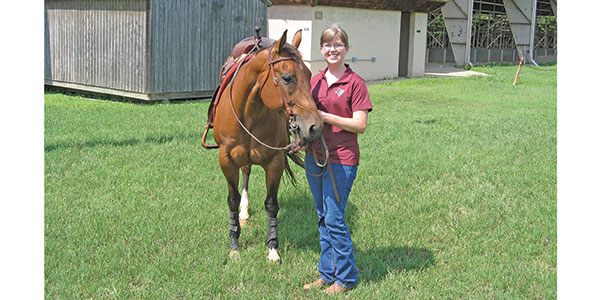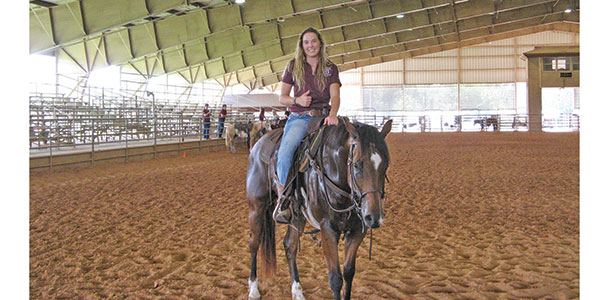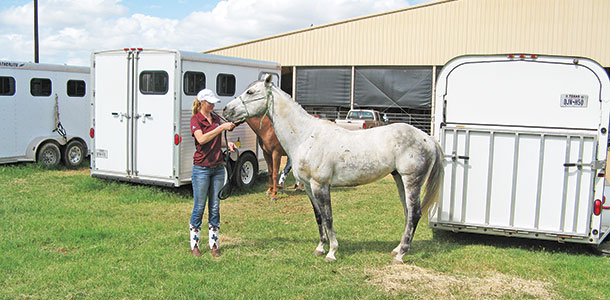Most ranch-raised people have always ridden horses just like we have always walked and talked.
Unless we train or show horses, very few of us have had formal training in horsemanship. If we manage to stay in the saddle, we probably think we are experts at handling horses.

This was what I thought until I met Teri Antilley, horse program specialist with Texas A&M AgriLife Extension Service, and the six student instructors who are conducting horsemanship clinics in various counties across Texas.
“For 42 consecutive years, the Texas A&M AgriLife Extension Service has trained and hired instructors to teach basic, intermediate and advanced horsemanship skills to youth and adults in various counties across Texas,” says Antilley.
“Each spring, university students are given the opportunity to become an instructor for the schools. Those who are interested are required to attend weekly riding sessions, which help educate applicants on the format and information presented at the summer horsemanship training events. Riding sessions are meant to give the prospective instructor time to learn how to teach various maneuvers in an easy-to-understand format while maintaining a positive atmosphere in a professional manner.”
The university students are required to furnish their own horse, tack, vehicle and trailer. They must have strong horsemanship skills plus the ability to teach.
The students must like working with people, especially youth, and must have the desire to grow as a horseman or horsewoman and educator. Although participants are encouraged to ride trained horses, the training is designed for the horse as well as the rider.
Training maneuvers
“The first skill a student learns is the rein aids,” explains Antilley. “We first use two hands to rein our horses, teaching the animals to follow their noses when they turn. When you want your horse to turn right, you pull your right hand back toward your hip. You don’t raise or lower your hand.
"A straight line should be maintained from the rider’s elbow to the bit. If you want the horse to turn left, you employ the same action with your left hand. This maneuver is referred to as the direct rein, open rein, plow rein, buggy rein or various other names.”

Once direct reining is mastered by the students, the class progresses to neck reining. Most of us were taught to ride by neck reining. This aid is performed with both bridle reins in one hand.
If we want the horse to turn left, we lay the right rein against its neck. For a right turn, we lay the left rein against the left side of the horse’s neck.
“Lateral movements mastered in our classes include side passes and two-tracking or leg yields,” says Antilley. “These maneuvers train horses to yield to pressure from the rider’s leg and bridle rein. Side passes are sideway movements with the horse’s body in a straight line from head to tail.
“When a leg yield or two-track is executed to the right, forward motion is added, and the horse’s head may flex very slightly or be straight with its body. The horse moves forward and to the right, away from pressure of the rider’s left leg. The horse also receives pressure from the reins held in the direction you want the horse to move. When the maneuver is executed properly, the horse’s left legs cross over the right legs with the forehand aligned with the hindquarters.”
Leg yield is a beautiful maneuver to watch. When the instructors rode into a line for their group photograph, they were too far apart to view all six of them in my camera lens.
I asked if they could move closer together and in unison, they quietly signaled their horses to leg yield toward the center of the line.
The entire maneuver took about two seconds. If they had broken the line and then reformed, it would have been like loading the starting gate at a race and would have required more time.
Other basic skills mastered by the class include speed control, collection and rollbacks. To master speed control, the rider must have developed responsiveness from the horse to his or her body position and rein aids.
Speed is controlled by sitting deeper or more forward in the saddle to go slower or faster, respectively, as well as using various rein aids when necessary.
Collection occurs when a horse carries more weight on the hind legs than the front legs. The horse draws its body together so that it becomes like a giant spring whose stored energy can be reclaimed.
Collection is an important ingredient in riding if the rider wishes to perform more advanced movements such as flying lead changes or jumping.
“Rollbacks are most often executed by loping a horse in a straight direction, coming to a complete halt, turning 180 degrees and loping off in the opposite direction,” explains Antilley.
“These maneuvers can also be executed in a walk or trot. Along with rollbacks, we work on gaits and leads. We teach our students how to transition their horses smoothly from one gait to another and how to position the horse to lope in the lead, either right or left.”
“After you and your horse have learned to successfully complete each maneuver, a team has developed between the two of you,” says Nicole Brooks. “Your horse needs to faithfully do what you ask of it, and the rider needs to give clear consistent instructions through reining or leg pressure. Building teams of horses and riders are what we try to accomplish in our horsemanship clinics.”
Team operations
“Halfway through the semester, those serious about teaching are then evaluated by performing a riding pattern that includes each maneuver they have been taught,” Antilley continues. “In addition, they must teach and demonstrate an assigned topic. Evaluations are reviewed by a committee, and decisions are made as to who will be officially hired. The hired students will continue to ride during the remainder of the semester to sharpen their skills in teaching and in working as a team to accomplish common goals.”
The teaching schedule is typically from late May through the end of June or the first week of July. Teams consist of two or three people, and the number of teams has varied from three to six.
Instructors are predominately female with an occasional male team member. Most of the instructors come from an urban setting and are majoring in animal science. In the past, some business and biology students have participated in the program.

Two of the 2013 student instructors, Jessica McDowell and Emilee Haubner, returned to qualify and teach again this year. In discussing their reasons for returning, it became very apparent that they both love children, enjoy teaching and like to be on horseback.
“I really enjoy working with children,” says McDowell. “Even though I’m graduating with an animal science degree, I want to train to become a physical therapist. It is great to see the smile on children’s faces when they master a maneuver in the horsemanship clinics. I try to work mostly on the ground assisting our students while my partner stays on her horse to demonstrate the maneuvers.”
“The horsemanship clinics give me an opportunity to work with people,” says Haubner. “Ages of students in one of our classes last year ranged from 6 to 60, and I enjoyed every one of them, especially the young children. The single digit-aged children are so quick to learn and absorb everything you tell them. As I explained to a class how one maneuver flowed into the next one, a teenager asked how he was supposed to know the first one. A 6-year-old immediately told him that the class learned it the day before. The teenager was very attentive during the remainder of the clinic.”
Maybe some of the rest of us are like the teenager and don’t know as much horsemanship as we think we do. Perhaps we ought to participate in a clinic so we can learn how to get better performance from our horses. ![]()
Robert Fears is a freelance writer based in Texas.
PHOTOS
PHOTO 1: The 2014 Texas A&M AgriLife Extension Service horsemanship instructors. From left to right: Nicole Brooks, Michelle Glover, Taylor Godwin, Chelsea Cooper, Emilee Haubner and Jessica McDowell.
PHOTO 2: Teri Antilley, a horse program specialist with Texas A&M AgriLife Extension Service and horsemanship instructor coach.
PHOTO 3: Nicole Brooks gives a “thumbs-up” for successful execution to the training maneuvers.
PHOTO 4: Jessica McDowell is wearing the official clothes of the horsemanship instructors. Photos by Robert Fears






